- Clone
- A3C6E2 (See other available formats)
- Regulatory Status
- RUO
- Workshop
- HLDA6
- Other Names
- Stem cell factor receptor, c-kit, mast cell growth factor receptor, steel factor receptor
- Isotype
- Mouse IgG1, κ
- Barcode Sequence
- GTAACTTCAGTATCG
- Ave. Rating
- Submit a Review
- Product Citations
- publications
| Cat # | Size | Price | Quantity Check Availability | Save | ||
|---|---|---|---|---|---|---|
| 323419 | 10 µg | 296€ | ||||
CD117 is a 145 kD protein tyrosine kinase also known as c-kit. It is a receptor for stem cell factor or c-kit ligand. CD117 is expressed on pluripotent hematopoietic progenitor cells (approximately 1-4% bone marrow cells), mast cells, and acute myeloid leukemic cells (AML). CD117 binding of c-kit ligand induces phosphorylation of CD117, and stimulates proliferation and survival of primitive hematopoietic stem cells as well as erythroid-committed and granulo-monocytic committed cells. The A3C6E2 antibody potently blocks the binding of SCF.
Product DetailsProduct Details
- Verified Reactivity
- Human
- Antibody Type
- Monoclonal
- Host Species
- Mouse
- Immunogen
- MOLM-1 megakaryocitic cell line
- Formulation
- Phosphate-buffered solution, pH 7.2, containing 0.09% sodium azide and EDTA
- Preparation
- The antibody was purified by chromatography and conjugated with TotalSeq™-D oligomer under optimal conditions.
- Concentration
- 0.5 mg/mL
- Storage & Handling
- The antibody solution should be stored undiluted between 2°C and 8°C. Do not freeze.
- Application
-
PG - Quality tested
- Recommended Usage
-
Each lot of this antibody is quality control tested by immunofluorescent staining with flow cytometric analysis and the oligomer sequence is confirmed by sequencing. TotalSeq™-D antibodies are compatible with Mission Bio’s Tapestri Single-Cell Sequencing Platform for simultaneous detection of DNA and Protein.
To maximize performance, it is strongly recommended that the reagent be titrated for each application, and that you centrifuge the antibody dilution before adding to the cells at 14,000xg at 2 - 8°C for 10 minutes. Carefully pipette out the liquid avoiding the bottom of the tube and add to the cell suspension. For Proteogenomics analysis, the suggested starting amount of this reagent for titration is ≤ 1.0 µg per million cells in 100 µL volume. Refer to the corresponding TotalSeq™ protocol for specific staining instructions.
Buyer is solely responsible for determining whether Buyer has all intellectual property rights that are necessary for Buyer's intended uses of the BioLegend TotalSeq™ products. For example, for any technology platform Buyer uses with TotalSeq™, it is Buyer's sole responsibility to determine whether it has all necessary third party intellectual property rights to use that platform and TotalSeq™ with that platform. - Application Notes
-
Additional reported applications (for the relevant formats) include: Blocking the binding of SCF. The Ultra-LEAF™ purified antibody (Endotoxin < 0.01 EU/μg, Azide-Free, 0.2 μm filtered) is recommended for functional assays (Cat. No. 323417 & 323418).
- Additional Product Notes
-
TotalSeq™-D reagents are designed to profile protein expression at single cell level. The Mission Bio Tapestri platform and sequencer (e.g. Illumina analyzers) are required. Please contact technical support for more information, or visit biolegend.com/totalseq/single-cell-dna
The barcode flanking sequences are CGAGATGACTACGCTACTCATGG (PCR handle), and GAGCCGATCTAGTATCTCAGT*C*G (capture sequence). * indicates a phosphorothioated bond, to prevent nuclease degradation.
View more applications data for this product in our Application Technical Notes. - RRID
-
AB_2936572 (BioLegend Cat. No. 323419)
Antigen Details
- Structure
- Growth factor receptor with tyrosine kinase activity, subclass III, approximately 145 kD
- Distribution
-
Pluripotent hematopoietic progenitor cells (approximately 1-4% bone marrow cells), mast cells, acute myeloid leukemic cells (AML)
- Function
- Growth factor receptor for stem cell factor. Induces proliferation and survival of primitive hematopoietic progenitors. Potent inducer of proliferation in erythroid-committed progenitor cells. Defects in CD117 have been linked to severe anemia and a decre
- Ligand/Receptor
- c-Kit ligand
- Modification
- Multiple phosphorylation sites
- Cell Type
- Embryonic Stem Cells, Hematopoietic stem and progenitors, Leukemia, Mast cells, Mesenchymal Stem Cells
- Biology Area
- Immunology, Stem Cells
- Molecular Family
- CD Molecules
- Antigen References
-
1. Giebel LB, et al. 1992. Oncogene 7:2207.
2. Furitsu T, et al. 1993. J. Clin. Invest. 92:1736. - Gene ID
- 3815 View all products for this Gene ID
- UniProt
- View information about CD117 on UniProt.org
Related FAQs
Other Formats
View All CD117 Reagents Request Custom Conjugation| Description | Clone | Applications |
|---|---|---|
| Purified anti-human CD117 (c-kit) | A3C6E2 | FC |
| Biotin anti-human CD117 (c-kit) | A3C6E2 | FC |
| PE anti-human CD117 (c-kit) | A3C6E2 | FC |
| PE/Cyanine5 anti-human CD117 (c-kit) | A3C6E2 | FC |
| PE/Cyanine7 anti-human CD117 (c-kit) | A3C6E2 | FC |
| PerCP/Cyanine5.5 anti-human CD117 (c-kit) | A3C6E2 | FC |
| Ultra-LEAF™ Purified anti-human CD117 (c-kit) | A3C6E2 | FC,Block |
| TotalSeq™-D1260 anti-human CD117 (c-kit) | A3C6E2 | PG |
Compare Data Across All Formats
This data display is provided for general comparisons between formats.
Your actual data may vary due to variations in samples, target cells, instruments and their settings, staining conditions, and other factors.
If you need assistance with selecting the best format contact our expert technical support team.
-
Purified anti-human CD117 (c-kit)
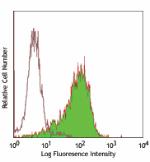
Human erythroleukemic cell line TF-1 stained with purified A... -
Biotin anti-human CD117 (c-kit)

Human erythroleukemia cell line TF-1 stained with biotinylat... -
PE anti-human CD117 (c-kit)
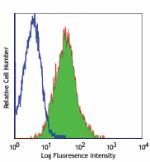
Human erythroleukemia cell line TF-1 stained with A3C6 PE -
PE/Cyanine5 anti-human CD117 (c-kit)
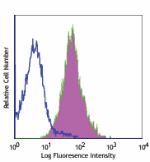
Human erythroleukemia cell line TF-1 stained with A3C6 PE/Cy... -
PE/Cyanine7 anti-human CD117 (c-kit)
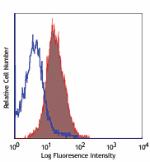
Human erythroleukemia cell line TF-1 stained with A3C6 PE/Cy... -
PerCP/Cyanine5.5 anti-human CD117 (c-kit)
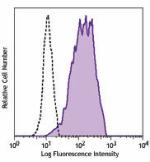
Human erythroleukemia cell line, HEL, was stained with CD117... -
Ultra-LEAF™ Purified anti-human CD117 (c-kit)
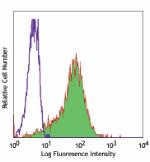
Human erythroleukemic cell line TF-1 stained with Ultra-LEAF... -
TotalSeq™-D1260 anti-human CD117 (c-kit)

 Login / Register
Login / Register 













Follow Us